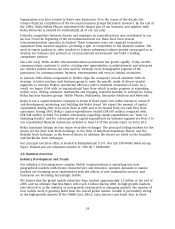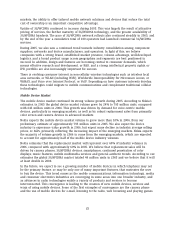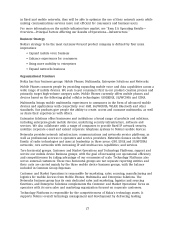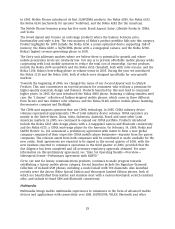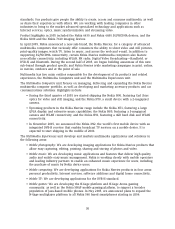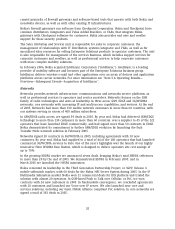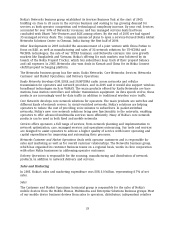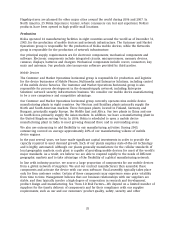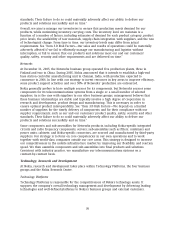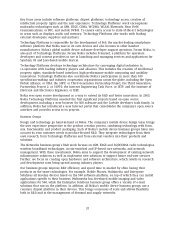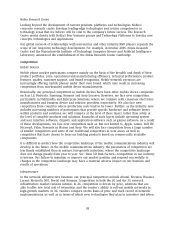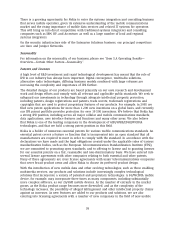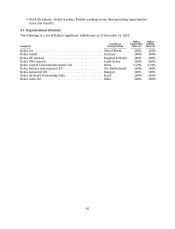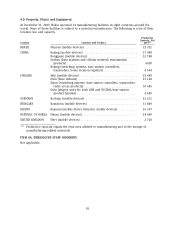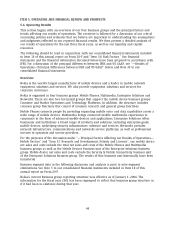Nokia 2005 Annual Report Download - page 36
Download and view the complete annual report
Please find page 36 of the 2005 Nokia annual report below. You can navigate through the pages in the report by either clicking on the pages listed below, or by using the keyword search tool below to find specific information within the annual report.and corporate customers. However, the percentage of the total device volume from each channel
varies by region. In the Asia-Pacific area, distributors and retailers account for more than half of
the total device volume. In China, handsets are sold almost solely through the retail channel. In
Europe, the Middle East and Africa, sales are split approximately equally between operators and
the other channels. In Latin America and North America, operator sales represent the major
percentage of our sales.
Each of our active operator and distributor customers is supported by a dedicated Nokia account
team. In addition, we have customer executive teams with Nokia Group Executive Board members
as the customer executives for the largest global operators.
We have also established specialized sales channels for certain business groups in order to reach
customers in segments where we are introducing mobility. Each of these channels is specific to,
and managed by, an individual business group. For example, Enterprise Solutions manages sales of
our security and mobile connectivity products and Nokia Business Center to certain resellers or
systems integrators who contribute value, such as consulting services or additional software,
before distribution.
Networks’ sales channels mainly comprise dedicated account management teams for operator
customers. The account management teams design solutions and suggest products based on
operator requirements. In addition to the marketing done within customer teams, Networks uses
customer events, exhibitions, brand marketing and an established interactive electronic channel.
As we are a global company and have sales in most countries of the world, in 2005 we also had
sales to customers in Iran, Libya and Syria. Furthermore, in 2004 we had very minor sales to
customers in Sudan, but none in 2005.
In 2005, we sold mobile devices and accessories to customers in Iran, Libya, and Syria. In addition,
we sold network equipment to a customer in Iran. In 2004, we also signed a network sales
contract with a customer in Libya, but that contract has not resulted in any sales by the end of
2005. In 2005, our aggregate sales to customers in Iran, Libya and Syria accounted for
approximately 1.2% of our total revenue or EUR 417 million. Iran and, to a lesser extent Syria, are
subject to U.S. economic sanctions that are primarily designed to implement U.S. foreign policy.
Marketing
According to a survey published in July 2005 by Interbrand, the Nokia brand was recognized as
the sixth most valued brand in the world. Since the early 1990s, Nokia’s products have largely
defined the Nokia brand in the minds of consumers, enabling the brand to build the equity it has
today.
In 2005, we introduced a new strategy to build on our existing brand strength. This was in
response to an increasingly complex industry environment and our push into new geographic and
business areas. The initial impact of this initiative is already evident in our product development
and design, in the greater harmonization of our visual identity and in our marketing activities in
different countries around the world.
We continue to invest in print, online and broadcast advertising, as well as sponsorship of a
variety of sporting and leisure events. High profile examples in 2005 include the Nokia FIS
snowboard world cup tour, the Live 8 concerts and the Nokia Sugar Bowl. We also promote our
products by securing product placements in movies so that Nokia phones feature prominently
alongside the lead characters.
During 2005, we opened our first Nokia Flagship store, in Moscow, giving consumers an
opportunity to test, experience and purchase products from our entire portfolio. More Nokia
34


